
A Chinatown is an ethnic enclave of Chinese people located outside Greater China, most often in an urban setting. Areas known as "Chinatown" exist throughout the world, including Europe, Asia, Africa, Oceania, and the Americas.

Ho Chi Minh City, formerly known as Saigon, is the most populous city in Vietnam, with a population of around 9 million in 2019. Situated in the Southeast region of Vietnam, the city surrounds the Saigon River and covers about 2,061 km2 (796 sq mi).

The Chinatown–International District of Seattle, Washington is the center of Seattle's Asian American community. Within the Chinatown International District are the three neighborhoods known as Seattle's Chinatown, Japantown and Little Saigon, named for the concentration of businesses owned by people of Chinese, Japanese and Vietnamese descent, respectively. The geographic area also once included Seattle's Manilatown. The name Chinatown/International District was established by City Ordinance 119297 in 1999 as a result of the three neighborhoods' work and consensus on the Seattle Chinatown International District Urban Village Strategic Plan submitted to the City Council in December 1998. Like many other areas of Seattle, the neighborhood is multiethnic, but the majority of its residents are of Chinese ethnicity. It is one of eight historic neighborhoods recognized by the City of Seattle. CID has a mix of residences and businesses and is a tourist attraction for its ethnic Asian businesses and landmarks.

Vietnamese Americans are Americans of Vietnamese ancestry. They comprise approximately half of all overseas Vietnamese and are the fourth-largest Asian American ethnic group following Chinese Americans, Filipino Americans, and Indian Americans. There are approximately 2.2 million people of Vietnamese descent residing in the U.S.

Little Saigon is a name given to ethnic enclaves of expatriate Vietnamese mainly in English-speaking countries. Alternate names include Little Vietnam and Little Hanoi, depending on the enclave's political history. To avoid political undertones due to the renaming of Saigon to Ho Chi Minh City, it is occasionally called by the neutral name Vietnamtown. Saigon is the former name of the capital of the former South Vietnam, where a large number of first-generation Vietnamese immigrants arriving to the United States originate, whereas Hanoi is the current capital of Vietnam.
Oklahoma City's Asia District, also known as the Asian District, is the center of Asian culture and International cuisine and commerce in the state of Oklahoma. It contains the largest population of Asian Americans and descendants from Asia in the state.

Chinatowns in Asia are widespread with a large concentration of overseas Chinese in East Asia and Southeast Asia and ethnic Chinese whose ancestors came from southern China—particularly the provinces of Guangdong, Fujian, and Hainan—and settled in countries such as Brunei, Cambodia, East Timor, Indonesia, India, Laos, Malaysia, Myanmar, the Philippines, Singapore, Sri Lanka, Thailand, Vietnam, Japan and Korea centuries ago—starting as early as the Tang dynasty, but mostly notably in the 17th through the 19th centuries, and well into the 20th century. Today the Chinese diaspora in Asia is largely concentrated in Southeast Asia however the legacy of the once widespread overseas Chinese communities in Asia is evident in the many Chinatowns that are found across East, South and Southeast Asia.

Urban Chinatowns exist in several major European cities. There is a Chinatown in London, England, as well as major Chinatowns in Manchester, Birmingham, Newcastle and Liverpool. In Paris there are two Chinatowns: one where many Vietnamese – specifically ethnic Chinese refugees from Vietnam – have settled in the Quartier chinois in the 13th arrondissement of Paris which is Europe's largest Chinatown, and the other in Belleville in the northeast of Paris. Berlin, Germany has two Chinatowns, one in the East and one in the West. Antwerp, Belgium also has an upstart Chinese community.
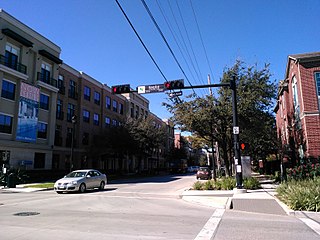
Midtown is a central neighborhood of Houston, located west-southwest of Downtown. Separated from Downtown by an elevated section of Interstate 45, Midtown is characterized by a continuation of Downtown's square grid street plan, anchored by Main Street and the METRORail Red Line. Midtown is bordered by Neartown (Montrose) to the west, the Museum District to the south, and Interstate 69 to the east. Midtown's 325 blocks cover 1.24 square miles (3.2 km2) and contained an estimated population of nearly 8,600 in 2015.
Born to Kill, also known as BTK or Canal Boys, is the name of a New York City-based street gang composed of first-generation Vietnamese immigrants. They were active in the 1980s in New York City's Chinatown. The early 1990s proved to be detrimental to the Vietnamese collective following the arrest and prosecution of most of their New York-based operatives by the fall of 1992.
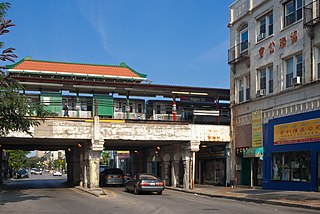
West Argyle Street Historic District is a historic district in northern Uptown, Chicago, Illinois. It was listed on the National Register of Historic Places on June 3, 2010. The community covers an area of about 41 acres (0.17 km2); its rough boundaries are N. Glenwood Ave to the west, Winona Street to the north, Sheridan Road to the east, and Ainslie Street to the south.

Chinatowns are enclaves of Chinese people outside of China. The first Chinatown in the United States was San Francisco's Chinatown in 1848, and many other Chinatowns were established in the 19th century by the Chinese diaspora on the West Coast. By 1875, Chinatowns had emerged in eastern cities such as New York City, Boston, and Philadelphia. The Chinese Exclusion Act of 1882 barred Chinese immigration to the United States, but the Magnuson Act of 1943 repealed it, and the population of Chinatowns began to rise again. In the 2010s, the downturn in the U.S. economy caused many Chinese Americans to return to China.
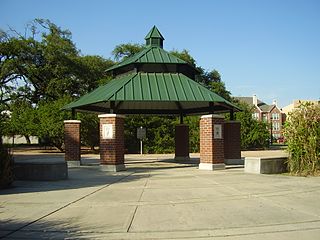
This article discusses the history of Vietnamese Americans and Vietnamese immigrants in Houston, Texas, and its environs. Vietnamese immigration has occurred in Greater Houston, including Fort Bend County and Harris County, since 1975, after the Vietnam War ended and refugees began coming to the United States.

One of the largest Vietnamese neighborhoods in Philadelphia is located in Passyunk Square, a neighborhood in South Philadelphia.
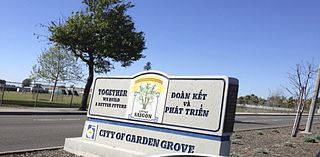
The Little Saigon district straddling the cities of Garden Grove and Westminster in Orange County, California is the largest Little Saigon in the United States. Saigon is the former name of the capital of the former South Vietnam, where a large number of first-generation Vietnamese immigrants originate.
Little Saigon is the Vietnamese ethnic enclave in the Clarendon neighborhood of Arlington, Virginia, which served the large refugee population that immigrated after the Fall of Saigon on April 30, 1975. One of many Little Saigons in the U.S., this neighborhood near Washington, D.C., became a hub of Vietnamese commerce and social activity, and reached its peak during the late 1970s to the early 1980s. The opening of the Clarendon station on the Washington Metro's Orange Line led to new development, generating higher rents, and businesses closed or relocated, notably to the nearby Eden Center.

The Historic Chinatown Gate is a modern Paifang archway in the Chinatown-International District neighborhood of Seattle, Washington.
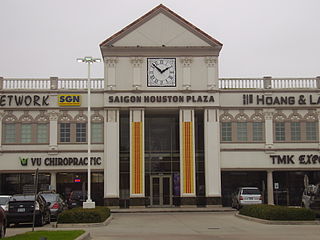
Little Saigon, also popularly known as Vietnamtown or simply Viet-Town, is a neighborhood in Houston, Texas centered on Bellaire Boulevard west of Chinatown. It is one of the largest Vietnamese enclaves in the United States.

Little Saigon is a neighborhood of San Jose, California, located in East San Jose. It is a hub for Silicon Valley's Vietnamese community and one of the largest Little Saigons in the world, as San Jose has more Vietnamese residents than any city outside of Vietnam. Vietnamese Americans and immigrants in San Jose make up ten percent of the city’s population and about eight percent of the county and South Bay Area.

Saigon Vietnam Deli is a Vietnamese restaurant in Seattle's Chinatown–International District, in the U.S. state of Washington.















